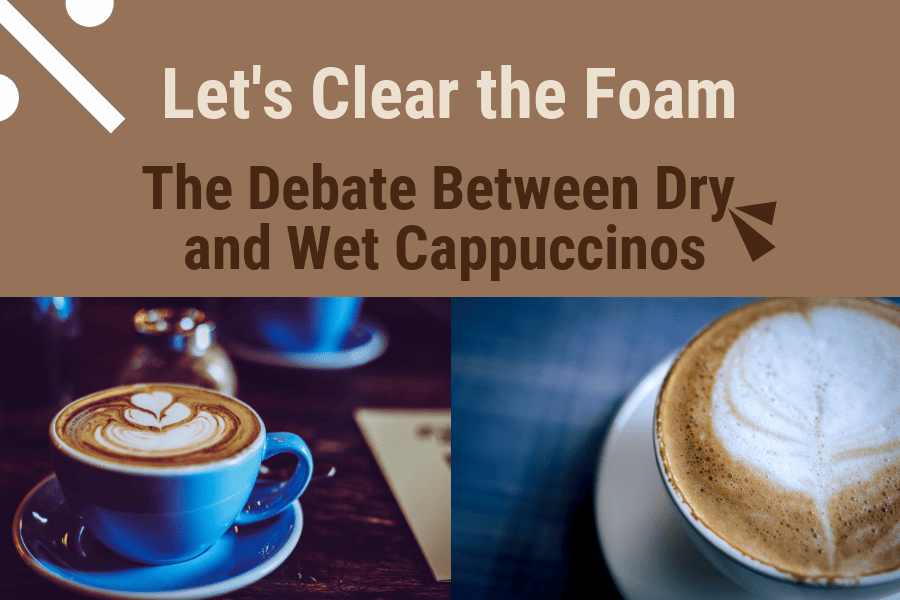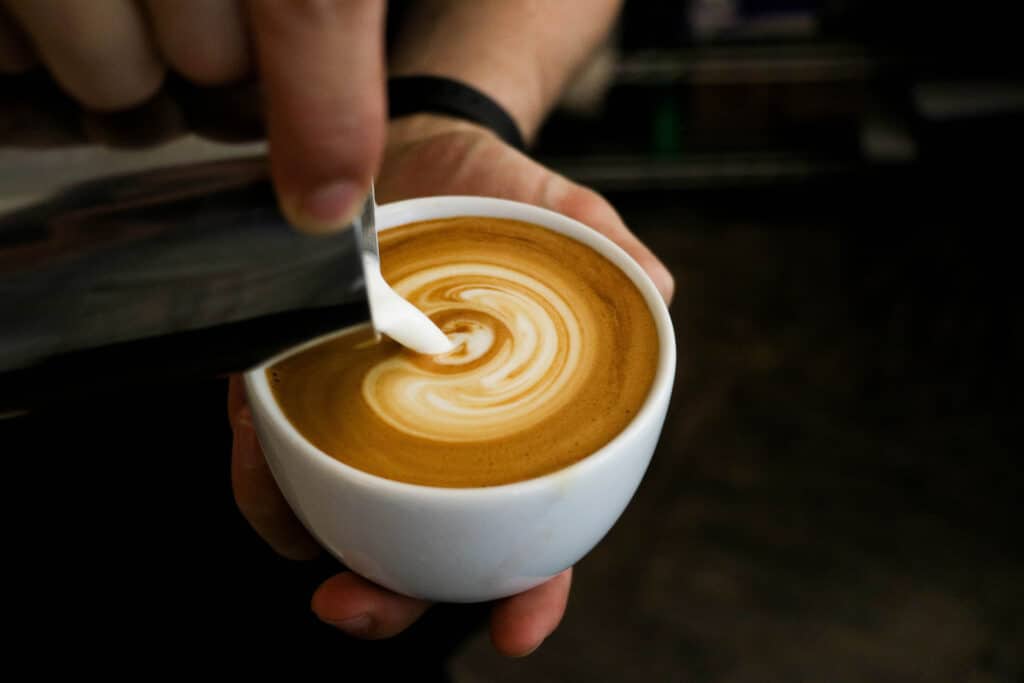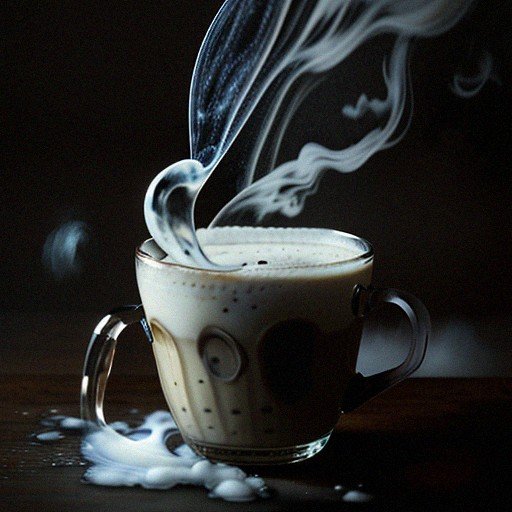Let’s Clear the Foam: The Debate Between Dry and Wet Cappuccinos

Coffee lovers around the world debate over whether a dry or wet cappuccino is better. Some prefer the foamy texture of a dry cappuccino, while others enjoy the creamy taste and smoothness of a wet one. But what really sets these two types apart?
In this article, we’ll clear the foam and delve deeper into the differences between dry and wet cappuccinos to help you make an informed decision on which is right for you. So sit back, grab your favorite cup of joe, and let’s dive in!
Understanding Cappuccinos: An Overview of Espresso-Based Drinks
Cappuccinos are a popular coffee choice among aficionados and newcomers alike. The drink is made up of equal parts espresso, steamed milk, and foam, with the foam creating a distinctive topping on top of the drink. However, cappuccinos come in two distinctly different forms: dry and wet.
A dry cappuccino has more foam than steamed milk, while a wet cappuccino has more steamed milk than foam.
The difference between these two variations goes beyond just texture – it affects taste as well.
Dry cappuccinos tend to be stronger in flavor due to the abundance of espresso and less diluted by milk or foam; meanwhile, wet cappuccinos have a creamier texture and milder taste thanks to their higher percentage of steamed milk.
Whether you prefer your coffee bold and strong or smooth and creamy will determine which type of cappuccino is right for you!
What Makes a Cappuccino “Dry” or “Wet”?
When it comes to cappuccinos, the difference between dry and wet lies in the ratio of foam to milk. A dry cappuccino has more foam than milk, creating a drier texture with a bubbly consistency. This is achieved by frothing the milk for longer to create a thicker layer of foam that sits on top of the espresso shot.
On the other hand, a wet cappuccino has less foam and more steamed milk compared to its dry counterpart. This creates a creamier taste with less pronounced bubbles in its texture. The combination of these components results in different flavor experiences when drinking each type of drink.
Ultimately, whether you prefer your cappuccino “dry” or “wet” depends on your personal taste preferences; some coffee drinkers enjoy stronger flavors while others may opt for a milder cuppa joe.
Now that we’ve unpacked what makes each variation unique, you can make an informed decision about which style suits you best!
The Milk Factor: How Foaming Affects Cappuccino Texture
Foaming plays a significant role in determining the texture of a cappuccino. The quantity and quality of foam determine whether the drink is dry or wet.
A dry cappuccino contains more foam than steamed milk, giving it a light and airy texture while still maintaining its strength.
On the other hand, a wet cappuccino has less foam and more steamed milk, which results in a smoother, creamier taste.The process that creates froth or foam from the milk involves introducing air into cold milk by using either steam or whisking with an electric mixer. This introduces tiny bubbles into the liquid forming micro-foam that gives drinks like latte’s their signature silky texture.
For making dry cappuccinos we need to allow enough time for whipping up maximum amount of micro-foam as well as reducing volume simultaneously via heating until around 140F–160F before pouring onto espresso shots.
In general preferences can vary on these factors but if you enjoy light and fluffy textures then go for drier version; however, if you prefer something smooth consistently rich then Wet Cappucinos would probably be best suited for your tastebuds!

The Art of Milk Steaming: Barista Tips for Perfect Foam
The art of milk steaming is a crucial skill for baristas who want to produce the perfect cup of coffee. Achieving the right texture and consistency can make all the difference in creating a delicious beverage.
To create foam, it’s important to understand how steam interacts with milk. As steam is introduced into the milk, it creates large bubbles that then need to be broken down by swirling or tapping the pitcher on a hard surface before pouring.When it comes to dry vs wet cappuccinos, there are distinct differences between how each one is made. A dry cappuccino has more foam and less milk than its wet counterpart.
This results in a lighter taste with a more pronounced espresso flavor. On the other hand, a wet cappuccino has less foam and more steamed milk which produces a creamier texture and sweeter taste profile.
Overall, mastering the art of milk steaming will give you an advantage in making exceptional espresso beverages. Whether you prefer your cappuccino dry or wet, understanding these techniques will help bring out their unique flavors while impressing any coffee lover who steps through your door!
Taste Test: Comparing the Flavor Profiles of Dry and Wet Cappuccinos
For those who aren’t familiar, a cappuccino is traditionally made with one-third espresso, one-third steamed milk, and one-third foam.
The difference between a dry and wet cappuccino lies in the amount of milk and foam used. A dry cappuccino has more foam than steamed milk compared to its wet counterpart which has less foam but more steamed milk in proportion to the espresso.
When it comes to flavor profiles, dry cappuccinos tend to be stronger since there’s less milk and more caffeine per sip. Depending on the brewing process used by your local cafe or barista, you may be able to detect richer notes of coffee flavor in a well-made cup of dry cappuccino than you would from its wet equivalent.
Contrarily, because there’s more steamed milk present in a wet cappuccino versus its drier variant whips into creamy softness while maintaining rich coffee notes that give it an overall smooth texture profile.
Whether you prefer your beverage dryer or creamier is entirely up to personal preference as both hot drinks can pack some serious taste explosions no matter how they’re prepared! So why not try sipping them side-by-side next time?
Who knows; maybe you’ll find drinking both options will showcase their complementary qualities depending on whether you seek bolder flavors or smoother textures for your morning brew!
The Italian Coffee Culture and Its Influence on Cappuccino Preferences
Italian coffee culture plays a significant role in the global popularity of cappuccinos. The classic Italian cappuccino is made with equal parts espresso, steamed milk, and foamed milk that is used to create intricate latte art.
In Italy, it’s considered a breakfast drink and never ordered after 11 am. However, in other parts of the world, it’s enjoyed any time throughout the day.
When preparing a dry or wet cappuccino outside of Italy, personal preference often dictates which variation people order. A dry cappuccino has less steamed milk than a wet one and more foam on top simultaneously resulting in better latte art and an intense taste of espresso.
While on the other hand ,the wet version has less distinct layers but rather is all mixed together due to increasing amounts of steamed milk creating an overall smoother texture.
In conclusion, understanding the differences between the two styles can help drinkers make informed decisions about what they prefer based upon their preferred flavor profile along with individual preferences for consistency or strength as dictated by cultural significance around these drinks from around the world including ones influenced heavily by Italian coffee culture like this beverage !

Choosing Your Perfect Cup: Factors to Consider When Deciding Between Dry and Wet Cappuccinos
Choosing between a dry and wet cappuccino can be overwhelming, but understanding your personal preference is the key to finding your perfect cup. A dry cappuccino contains more foam, resulting in a thicker texture with less milk. This creates an intense coffee flavor with a light and airy finish that many people enjoy.
On the other hand, wet cappuccinos have increased amounts of steamed milk for a smoother taste and texture.In addition to individual preferences, several factors should be considered when choosing between dry and wet cappuccinos. One of these factors includes the type of beans used to make your coffee as some bean varieties tend to blend better with either one or the other type of cappuccino.
Another aspect you may want to factor in is whether you are looking for calorie reduction as this plays a role when considering portions of water vs milk being added per serving size mostly associated with each kind, respectively; hence there’s no hard rule on which among them has more calories compared to the other since it depends primarily on how much extra sugar we put ourselves into getting that perfectly blended brew mastered over years by professionals behind our local bar counters!





